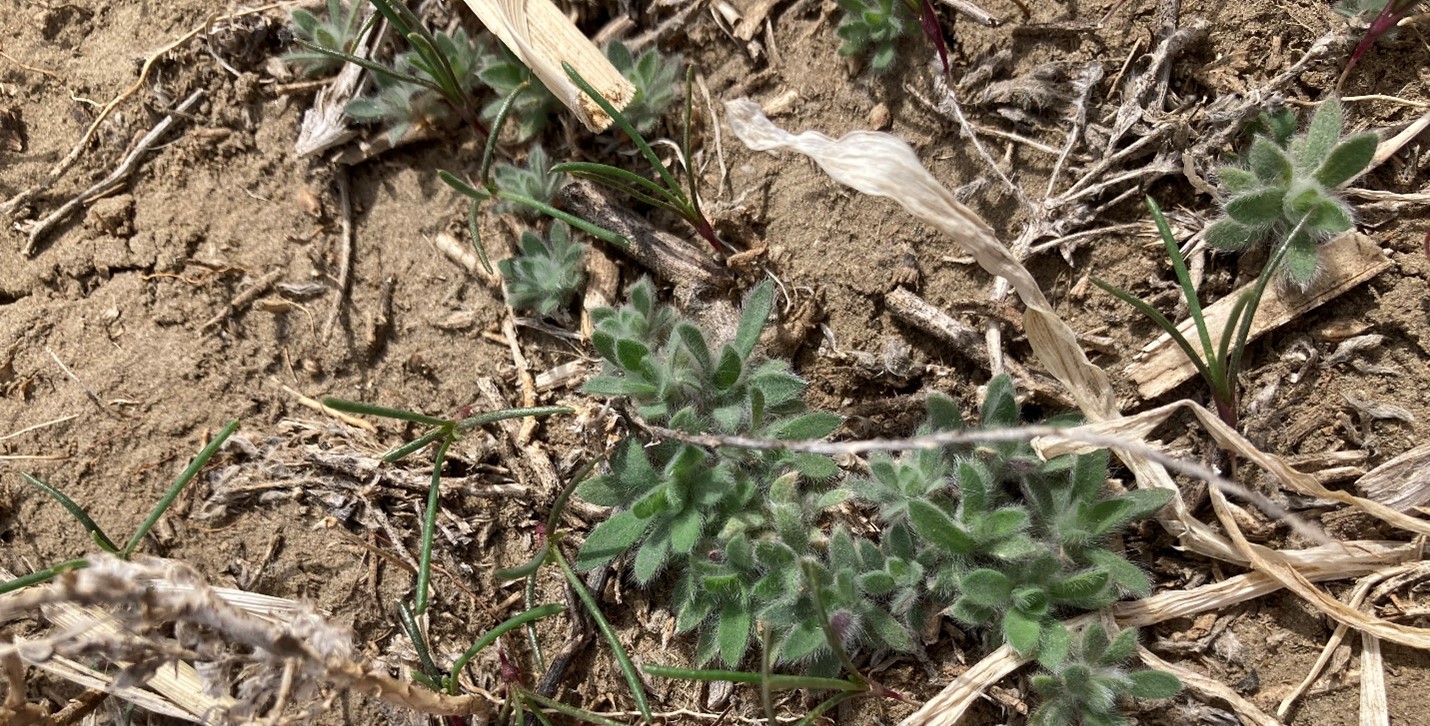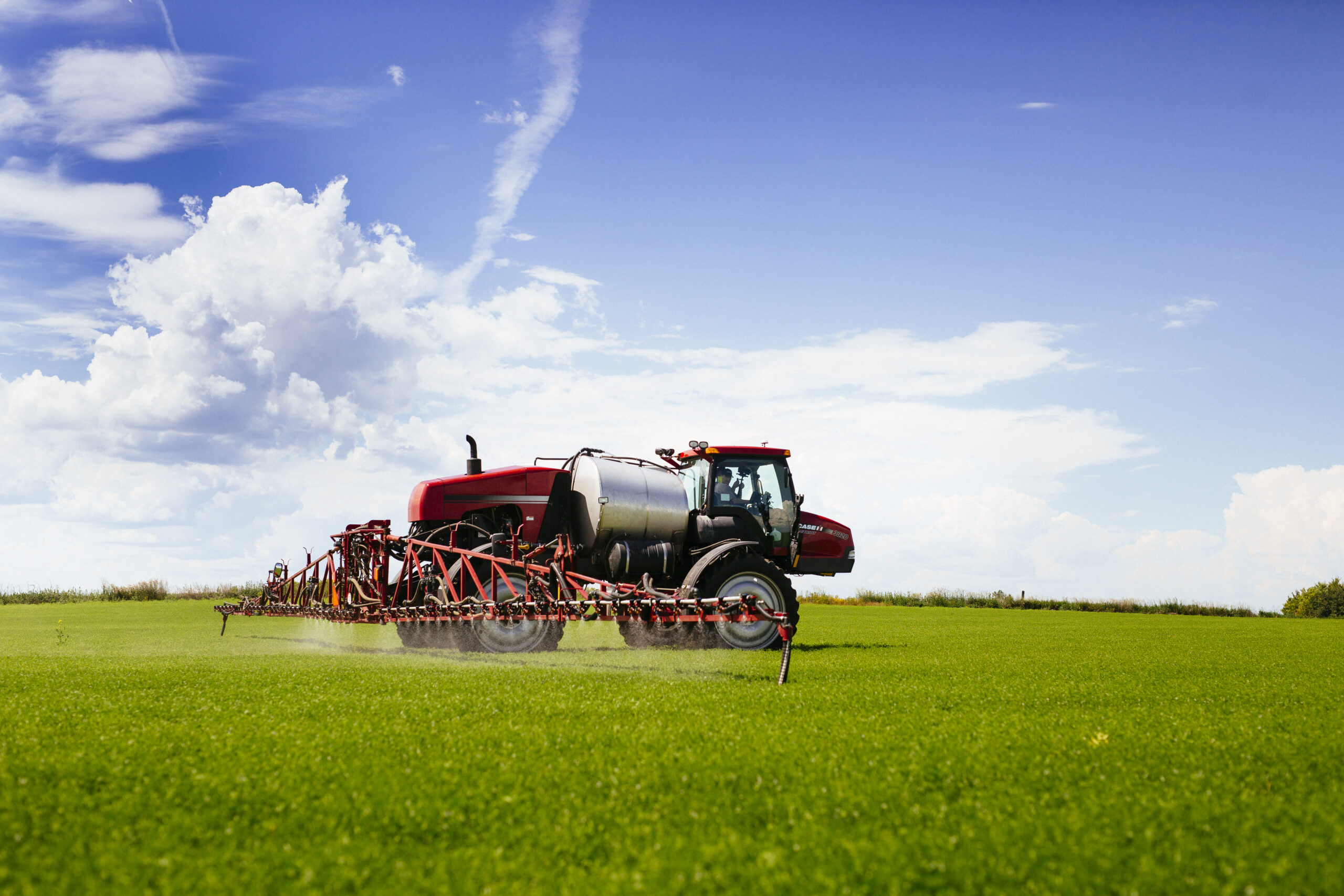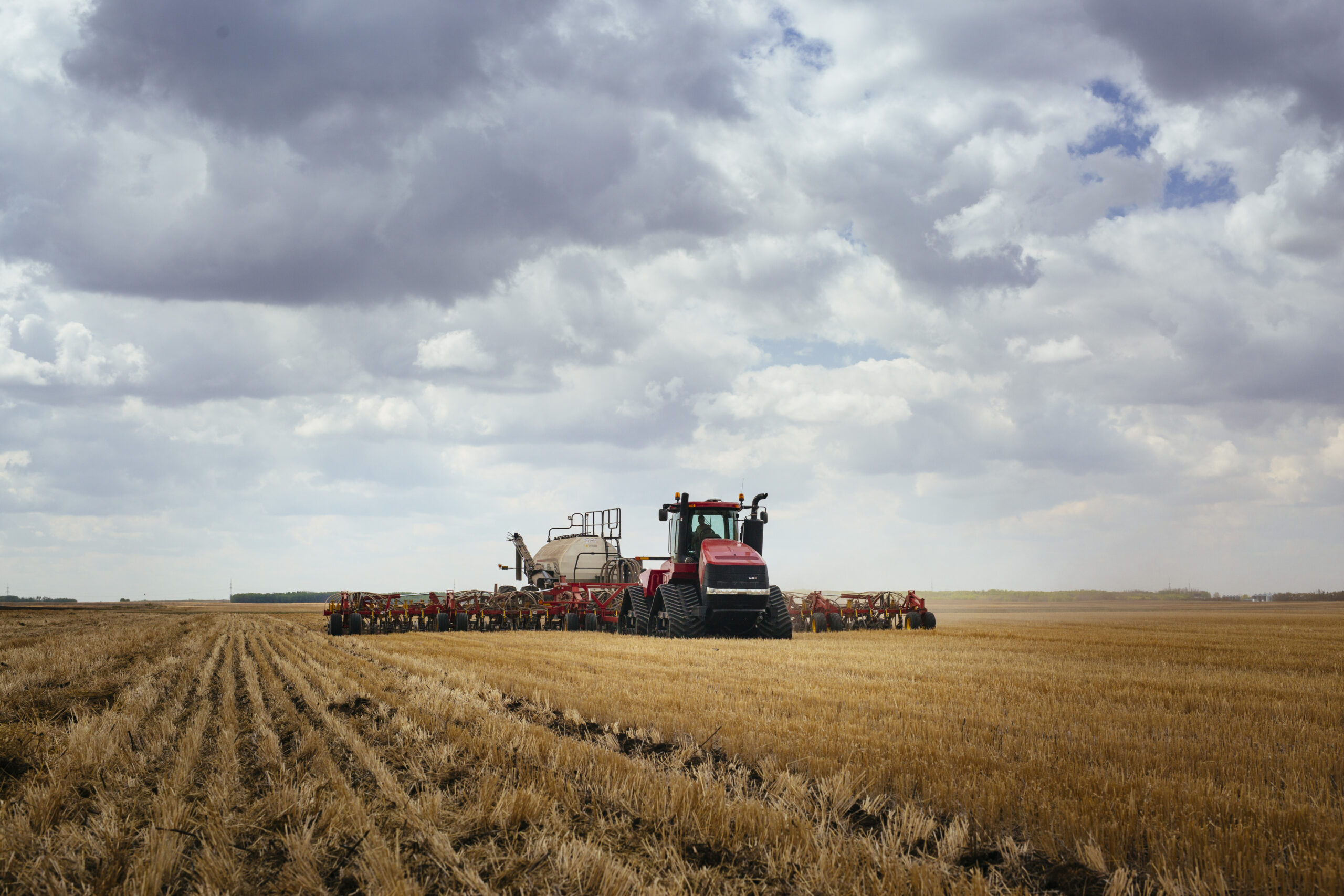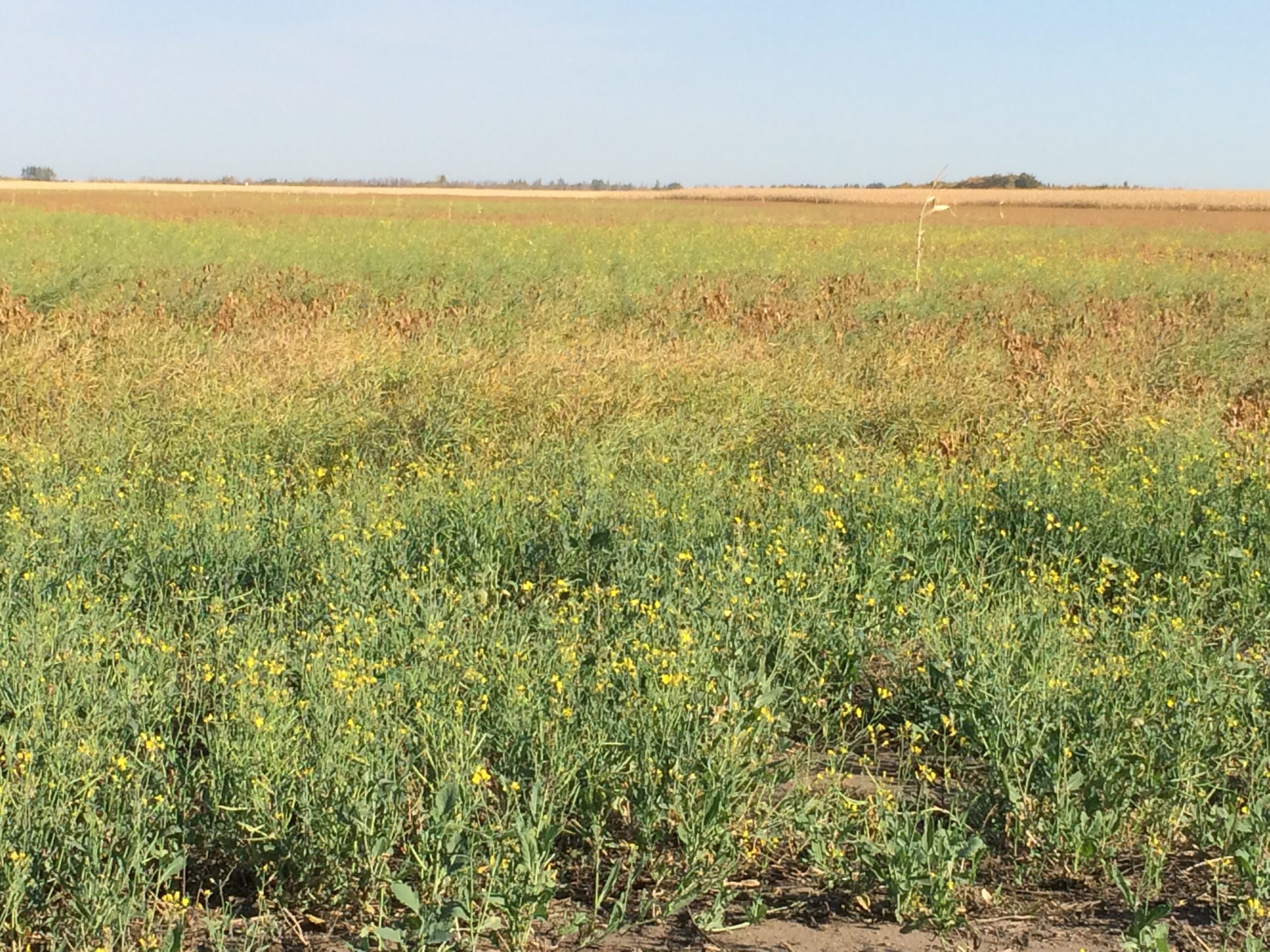Background
Kochia and Russian thistle are problematic weeds in Western Canada. Due to their aggressive growth habit, excellent adaptability to hot and dry conditions, and predisposition to herbicide resistance, both species are of particular concern in pulse crops. Kochia and Russian thistle are both prolific seed producers with excellent dispersion capabilities as tumbleweeds. Drought tolerance of both species is largely attributed to their deep root growth, ability to close off stomata to minimize moisture losses during periods of heat and drought, and their photosynthetic efficiency in response to increasing temperatures as a C4 plant. Kochia populations resistant to herbicide Groups 2, 4, and/or 9 have been identified across the Canadian prairies with herbicide resistant populations of Russian thistle detected in the United States. Additional information on kochia biology and management can be found in Kochia in Pulse Crops.
In a project led by Agriculture and Agri-Food Canada (AAFC), kochia and Russian thistle populations were surveyed in Manitoba (2018), Saskatchewan (2019), and Alberta (2021) for herbicide resistance toward glyphosate and dicamba. Samples were collected at approximately 300 sites in each province using a stratified random survey approach with herbicide screening for Manitoba and Saskatchewan sites completed by Dr. Charles Geddes, AAFC Research Scientist in Lethbridge and Dr. Shaun Sharpe, AAFC Research Scientist in Saskatoon, respectively. Screening of Alberta samples is ongoing.
Key Findings
- 88% of kochia populations surveyed in Saskatchewan demonstrated some degree of glyphosate resistance.
- Glyphosate resistance in Saskatchewan kochia has substantially increased compared to the previous survey conducted in 2015.
- Preliminary screening results indicated 40% of kochia populations surveyed in Saskatchewan demonstrated some degree of dicamba resistance.
- 79% of Russian thistle populations surveyed in Saskatchewan demonstrated some degree of glyphosate resistance.
- 23% of Russian thistle populations surveyed in Saskatchewan demonstrated some degree of dicamba resistance.
- Of the Russian thistle populations identified as glyphosate-resistant, three populations also demonstrated dicamba resistance.
- Glyphosate-resistant Russian thistle was distributed across Saskatchewan, but dicamba-resistant populations were in the far west and southwest regions of the province.
Manitoba
Screening for the Manitoba Russian thistle populations were completed with no resistance to glyphosate or dicamba. Screening of the Manitoba kochia populations were completed and glyphosate resistance was detected in 58% of populations. Approximately 1% of the populations were dicamba-resistant and two populations were resistant to both dicamba and glyphosate. This is the first documentation of dicamba-resistant kochia in Manitoba. A high degree (70 to 80%) of kochia populations found in corn and soybean fields were glyphosate-resistant.
Saskatchewan
The Saskatchewan post-harvest survey for herbicide resistance was conducted on 308 sites in southern Saskatchewan in the fall of 2019. Kochia was harvested for 303 locations while Russian thistle was harvested from 25 locations. Most of these samples were collected from field locations (n=253) compromising of canola (26%), spring wheat (25%), lentil (13%), barley (7%), flax (4%), and pea (4%). The remaining populations originated in ditches adjacent to agricultural fields (n=56), oil wells (n=9), and railways (n=8). Samples were threshed and then subsequently screened to categorize resistance levels.
| Resistance Range (%) | Resistance Categorization |
|---|---|
| 0 | Susceptible Population |
| 1 to 20 | Low Resistance |
| 21 to 60 | Moderate Resistance |
| 61 to 100 | Highly Resistant Population |
Kochia Results
Of the 283 kochia populations with viable seed, 88% of populations demonstrated some degree of resistance to glyphosate. A total of 23% of populations had a high degree of glyphosate resistance. A high degree of resistance is defined as at least 61% of the treated plants surviving glyphosate application. A total of 34% of the kochia populations demonstrated a moderate level of resistance (21 to 60% survival). Lastly, 32% of the populations demonstrated low resistance (1 to 20% survival). Only 12% of populations were susceptible entirely to glyphosate. Glyphosate resistance has increased substantially compared the previous survey round where 17 out of 342 populations were demonstrated to be resistant (Beckie et al., 2015).
Alternatively, preliminary results for dicamba screening indicates very low level of selection for dicamba-resistant traits in many of the populations. Given how rapidly glyphosate-resistance has spread within kochia in both Saskatchewan and Manitoba, it is feasible that spread of dicamba-resistant traits may well also quickly spread. The low-level resistance doesn’t appear to be focused on any locale No dicamba resistance had been previously reported in the survey in Saskatchewan but dicamba-resistant kochia has been identified in Alberta in 2017 (Beckie et al., 2019).
Table 1. Kochia population resistance overview for Saskatchewan.
| Glyphosate | Dicamba | ||
|---|---|---|---|
| Resistance Range (%) | Populations (no.) | Resistance Range (%) | Populations (no.) |
| 0 | 33; 12% | 0 | 32; 60% |
| 1 to 20 | 91; 32% | 1 to 20 | 20; 38% |
| 21 to 60 | 95; 34% | 21 to 60 | 1; 2% |
| 61 to 100 | 64; 23% | 61 to 100 | 0; 0% |
| Total Population: | 283 | Total Population: | 53 |
| Resistance: | 88% | Resistance: | 40% |
Glyphosate screening is complete but dicamba screening is still ongoing, so results are preliminary.


Russian Thistle Results
A total of 79% of Russian thistle populations were demonstrating resistance towards glyphosate. Of these populations, three of them also demonstrated dicamba resistance. Selection is progressing primarily against glyphosate with additional resistance towards dicamba in those same populations only. Glyphosate-resistance has increased (79%) among the study populations. Much of
the impacted populations are demonstrating low to moderate resistance, with only one population showing substantial shift towards a resistant biotype. Glyphosate resistance appears to be widespread geographically in the province, not clustered in any particular rural municipality. Alternatively, the dicamba-resistant biotypes were encountered in the far west and southwest part of Saskatchewan.
Table 2. Russian thistle screening results for the 2019 post-harvest resistant weed survey in Saskatchewan.
| Glyphosate | Dicamba | ||
|---|---|---|---|
| Resistance Range (%) | Populations (no.) | Resistance Range (%) | Populations (no.) |
| 0 | 4; 21% | 0 | 10; 77% |
| 1 to 20 | 6; 32% | 1 to 20 | 2; 15% |
| 21 to 60 | 8; 42% | 21 to 60 | 1; 8% |
| 61 to 100 | 8; 5% | 61 to 100 | 0; 0% |
| Total Population: | 19 | Total Population: | 13 |
| Resistance: | 79% | Resistance: | 23% |


Conclusions and Recommendations
Herbicide resistance in kochia and Russian thistle populations is a growing concern across western Canada, with very high levels of glyphosate-resistance documented in Saskatchewan and Manitoba kochia populations. The high degree of spread is likely a consequence of kochia’s wind-driven dispersal via tumbleweeds and resistance spreading during flowering with pollen movement.
While glyphosate still has efficacy on some kochia plants within the population, the risk for further resistance evolving is high when glyphosate is used alone. This is similarly true for Russian thistle in Saskatchewan. Using multiple modes of action to kill these weeds is paramount for combating resistance including:
- Pre-seeding tank-mixing involving glyphosate
- Sequential applications and layering during the field season including in-crop, pre-harvest, and post-harvest sprays
- Rotating modes of action between years when feasible.
The dicamba-resistance kochia biotypes identified in the Saskatchewan survey have between 1 to 20% survivorship so it is also recommended to use multiple effective modes of action either sequentially or in mixture with dicamba, excluding glyphosate, to ensure good control and preventing further selection pressure.
For kochia, it will be necessary to think outside of the critical period for weed control and try to achieve season-long control when at all possible. Boundaries and margins will need to be monitored and managed to prevent kochia from going to seed and tumbling.
Given the evolution of both glyphosate- and dicamba-resistance in Saskatchewan, an awareness campaign on identification and management is recommended to prevent further escalation. Increased control in marginal land where tumbleweeds may disperse will be important to prevent buildup in the environment and enhance the opportunity for invasion into the field. This is recognized as a best management practice for preventing and mitigating resistance (Norsworthy et al., 2012).
References
- Beckie HJ, Gulden RH, Shaikh N, Johnson EN, Willenborg CJ, Brenzil CA, Shirriff SW, Lozinski C, Ford G (2015) Glyphosate-resistant kochia (Kochia scoparia L. Schrad.) in Saskatchewan and Manitoba. Canadian Journal of Plant Science 95:345-349
- Beckie HJ, Hall LM, Shirriff SW, Martin E, Leeson JY (2019) Triple- resistant kochia [Kochia scoparia (L.) Schrad.] in Alberta. Canadian Journal of Plant Science 99:281-285
- Norsworthy JK, Ward SM, Shaw DR, Llewellyn RS, Nichols RL, Webster TM, Bradley KW, Frisvold G, Powles SB, Burgos NR, Witt WW, Barrett M (2012). Reducing the risks of herbicide resistance: Best management practices and recommendations. Weed Sci. 60:31-62
Acknowledgements
SPG would like to thank the AAFC weed science teams led by Dr. Shaun Sharpe and Dr. Charles Geddes for their dedication in identifying herbicide resistance weed populations on the prairies. Funding support for this survey been provided by Alberta Wheat Commission, Manitoba Pulse and Soybean Growers, Manitoba Crop Alliance, Saskatchewan Canola Development Board, Saskatchewan Pulse Crop Development Board, Saskatchewan Wheat Development Commission, and Western Grains Research Foundation
Contributors/Authors
Dr. Shaun Sharpe, Research Scientist (Weeds), AAFC
Dr. Charles Geddes, Research Scientist (Weeds), AAFC Sarah Anderson, Agronomy Manager, SPG
Published April 2022



